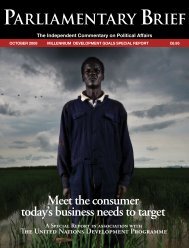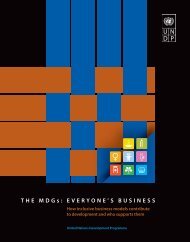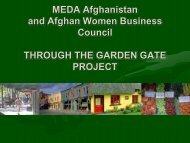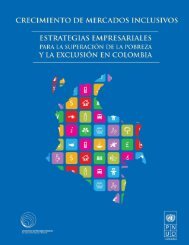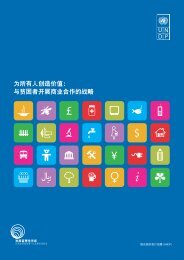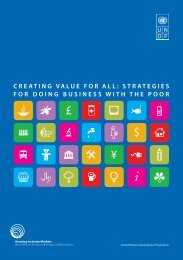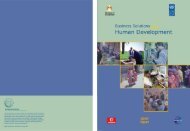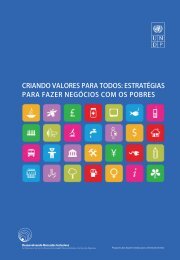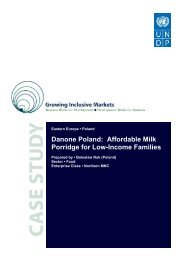Pot-in-pot Enterprise: Fridge for the Poor - Growing Inclusive Markets
Pot-in-pot Enterprise: Fridge for the Poor - Growing Inclusive Markets
Pot-in-pot Enterprise: Fridge for the Poor - Growing Inclusive Markets
You also want an ePaper? Increase the reach of your titles
YUMPU automatically turns print PDFs into web optimized ePapers that Google loves.
IntroductionThe <strong>pot</strong>-<strong>in</strong>-<strong>pot</strong> enterprise, designed to help improve <strong>the</strong> well-be<strong>in</strong>g of rural dwellers, wasconceived <strong>for</strong> <strong>the</strong> arid region of nor<strong>the</strong>rn Nigeria which lies ma<strong>in</strong>ly with<strong>in</strong> <strong>the</strong> grassland of <strong>the</strong>Sudan and Sahel Savannah vegetation belts. These regions are characterized largely by desertfeatures: hot days and high diurnal temperatures, low relative humidity and low ra<strong>in</strong>fall that isconcentrated with<strong>in</strong> three months. The area covers approximately 397,170 km 2 (43% of Nigeria’stotal land area). The vegetation is ma<strong>in</strong>ly desert scrubland. In terms of natural resourceoccurrence, <strong>the</strong> region is <strong>the</strong> least endowed <strong>in</strong> Nigeria. Incidentally, <strong>the</strong> region is home to about35.1% (49.1 million) of Nigeria’s 140 million people. 1 Dom<strong>in</strong>ated by <strong>the</strong> Islamic religion andculture, <strong>the</strong> <strong>in</strong>habitants of <strong>the</strong> region are also <strong>the</strong> least educated population <strong>in</strong> <strong>the</strong> country.In terms of occupation, <strong>the</strong> people are mostly subsistence farmers and cattle rearers. The shortcropp<strong>in</strong>g period of three months result<strong>in</strong>g from low ra<strong>in</strong>fall duration, implies that <strong>for</strong> n<strong>in</strong>emonths, <strong>the</strong> people have to depend on <strong>the</strong> farm produce planted dur<strong>in</strong>g those months and pastsav<strong>in</strong>gs (if any) to survive. Consequently, <strong>the</strong> capacity to store food products dur<strong>in</strong>g harvestperiod becomes very critical <strong>for</strong> household food security. The poverty of <strong>the</strong> region is fur<strong>the</strong>rcompounded by <strong>the</strong> fact that all <strong>the</strong> farmers produce similar farm products, which stiflesexchange and commerce. The region lacks good roads to l<strong>in</strong>k <strong>the</strong>m up with <strong>the</strong> few urban centreswhere <strong>the</strong>ir crops are needed. Where <strong>the</strong> roads exist, <strong>the</strong>y are <strong>in</strong> deplorable conditions. The ruralareas <strong>in</strong> this region also lack access to modern electricity supply. Consequently, farmers sell <strong>the</strong>irfarm produce at cheap prices, o<strong>the</strong>rwise <strong>the</strong> farm products will go rotten. When <strong>the</strong> crops rot, <strong>the</strong>stench and its implications also create serious health and environmental problems as flies <strong>in</strong>vade<strong>the</strong> house and <strong>the</strong> compounds become unsightly.Gett<strong>in</strong>g out of poverty is thus a major challenge whose solution was (and is still) far beyond <strong>the</strong>capacity of <strong>the</strong> rural dwellers. The simple solution to <strong>the</strong> problem of <strong>the</strong>se rural folks lies <strong>in</strong> ei<strong>the</strong>rprovid<strong>in</strong>g access roads to l<strong>in</strong>k <strong>the</strong>m up with <strong>the</strong> urban centres <strong>for</strong> <strong>the</strong>m to sell <strong>the</strong>ir farm produce,as well as open up <strong>the</strong> local economy to outside <strong>in</strong>vestors to create non-farm employment, or,provid<strong>in</strong>g electricity that will allow <strong>for</strong> opportunities <strong>for</strong> refrigeration so that <strong>the</strong> farm productscould be stored to prolong <strong>the</strong>ir shelf life. These two solutions lie <strong>in</strong> <strong>the</strong> purview of <strong>the</strong> State.Incidentally, <strong>in</strong> <strong>the</strong> last 49 years of <strong>in</strong>dependence, <strong>the</strong> size of <strong>the</strong> nation, <strong>the</strong> smallness 2 anddispersed nature of rural communities as well as dw<strong>in</strong>dl<strong>in</strong>g resources have been major factorsconstra<strong>in</strong><strong>in</strong>g <strong>the</strong> access of <strong>the</strong> region to <strong>the</strong> supply of social overheads, notably roads andelectricity.1 NPC (2006)2 Rural areas <strong>in</strong> Nigeria are small villages compris<strong>in</strong>g of few households with a population of less than 1,000<strong>in</strong> most cases. This makes it costly and difficult to access <strong>the</strong>m to roads, water and electric l<strong>in</strong>es.Case Study ● <strong>Pot</strong>-<strong>in</strong>-<strong>pot</strong> <strong>Enterprise</strong>: <strong>Fridge</strong> <strong>for</strong> <strong>the</strong> <strong>Poor</strong> 3







